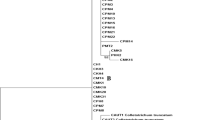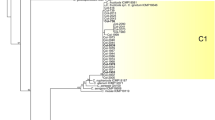Abstract
Colletotrichum spp. are causal agents of anthracnose disease in chili fruits and other tropical crops. The disease is increasing in chili fruits in Thailand and significantly reduces fruit quality and fruit production. Forty-eight isolates of Colletotrichum spp. associated with chili anthracnose were collected from different areas of Thailand during 2010–2015. Based on morphological characteristic identification, 10 isolates were shown to belong to the C. gloeosporioides species complex, 24 isolates belong to the C. acutatum species complex and 14 isolates to C. capsici. For molecular identification, two primer sets, ITS1/ITS4 and ACT528/ACT738, were used for amplification of the internal transcribed spacer of rRNA gene (ITS1–5.8S–ITS2) and partial region actin gene (ACT), respectively. The phylogenetic analysis of individual and combined ITS region and actin nucleotide sequences identified the collected isolates into 4 species: C. gloeosporioides, C. siamense, C. acutatum and C. capsici. The pathogenicity test demonstrated that all four species were pathogenic on intact unwounded and healthy fruits. These results indicated that C. capsici, C. acutatum, C. gloeosporioides and C. siamense were the causal agents of chili anthracnose disease.







Similar content being viewed by others
References
Alexander PJ, Rajanikanth G, Bacon CD, Bailey CD (2007) Recovery of plant DNA using a reciprocating and silica-based columns. Mol Ecol Resour 7:5–9
Carbone I, Kohn LM (1999) A method for designing primer sets for speciation studies in filamentous ascomycetes. Mycologia 91:553–556
Crouch JA, Clarke BB, Hillman BI (2009) What is the value of ITS sequence data in Colletotrichum systematics and species diagnosis? A case study using the falcate-spored graminicolous Colletotrichum group. Mycologia 101:648–656
Daniel HM, Meyer W (2003) Evolution of ribosomal RNA and actin gene sequences for the identification of ascomycetous yeasts. Int. J. Food Microbiol 86:61–78
Du M, Schardl CL, Nuckles EM, Vaillancourt LJ (2005) Using mating-type gene sequences for improved phylogenetic resolution of Colletotrichum species complexs. Mycologia 97(3):641–658
Hong JK, Hwang BK (1998) Influence of inoculum density, wetness duration, plant age, inoculation method, and cultivar resistance on infection of pepper plants by Colletotrichum coccodes. Plant Dis 82:1079–1083
Hall TA (1999) BioEdit: a user-friendly biological sequence alignment editor and analysis program for windows 95/98/NT. Nucleic Acids Symp Ser 41:95–98
Ivery MLL, Diaz CN, Miller SA (2004) Identification and management of Colletotrichum acutatum on immature bell peppers. Plant Dis 88:1198–1204
Johnston PR, Jones D (1997) Relationship among Colletotrichum isolates from fruit rot assessed using rDNA sequences. Mycologia 89:420–430
Kim JT, Park SY, Choi W, Lee YH, Kim HT (2008) Characterization of Colletotrichum isolates causing anthracnose of pepper in Korea. Plant Pathol J 24:17–23
Manandhar JB, Hartman GL, Wang TC (1995) Anthracnose development on pepper fruits inoculated with Colletotrichum gloeosporioides. Plant Dis 79:380–383
Meetum P, Leksomboon C, Kanjanamaneesathian M (2015) First report of Colletotrichum aenigma and C.simense, the causal agents of anthracnose disease of dragon fruit in Thailand. J. Plant Pathol 97(2):391–403
Nam MH, Park MS, Lee HD, Yu SH (2013) Taxonomic re-evaluation of Colletotrichum gloeosporioides isolated from strawberry in Korea. Plant Pathol J 29:317–322
Reeb V, Lutzoni F, Roux C (2004) Contribution of RPB2 to multilocus phylogenetic studies of the euascomycetes (Pezizomycotina, fungi) with special emphasis on the lichen-forming Acarosporaceae and evolution of polyspory. Mol Phylogenet Evol 32:1036–1060
Sharma PN, Sharma M, Sharma OP, Pathania A (2005) Morphological pathological and molecular variability in Colletotrichum capsici, the cause of fruit rot of chilli in the subtropical region of north-western India. J Phytopathol 153(4):232–237
Sutton BC (1980) The Coelomycetes: fungi imperfect with pycnidia acervuli and stromata. Commonwealth Mycological Institute, Kew
Sutton BC (1992) The genus Glomorella and its anamorph Colletotrichum. In: Bailey JA, Jeger MJ (eds) Colletotrichum: biology pathology and control. CAB International, Wallingford, pp 1–26
Tamura K, Peterson D, Peterson N, Stecher G, Nei M, Kumar S (2011) MEGA5: molecular evolutionary genetics analysis using maximum likelihood, evolutionary distance, and maximum parsimony methods. Mol Biol Evol 28:2731–2739
Than PP, Jeewon R, Hyde KD, Pongsupasamit S, Mongkolporn O, Taylor PWJ (2008) Characterization and pathogenicity of Colletotrichum species associated with anthracnose disease on chili (Capsicum spp.) in Thailand. Plant Pathol 57:562–572
Thompson JD, Higgins DG, Gibson TJ (1994) CLUSTALW: improving the sensitivity of progressive multiple sequence alignment through sequence weighting, position-specific gap penalties and weight matrix choice. Nucleic Acids Res 22:4673–4680
Wei Y, Boa J, Cao H, Zhai J, Jantasuriyarat C, Zuo S, Pan X, Wang H, Zhou B (2014) Haplotype variation and phylogeography of Rhizoctonia solani AG1-IA strains based on rDNA5.8S-ITS and ß-actin gene sequence analyses. Mycol Progress 13:247–255
Weir BS, Johnston PR, Damm U (2012) The Colletotrichum gloeosporioides species complex. Stud Mycol 73:113–180
White TJ, Bruns T, Lee S, Taylor J (1990) Amplification and direct sequencing of fungal ribosomal RNA genes for phylogenetics. In: Innis MA, Gelfand DH, Sininsky JJ, White TJ (eds) PCR Protocols. Academic, San Diego, pp 315–322
Acknowledgements
In this work, we wish to acknowledge the financial support from the Thailand Research Fund (TRF) through the Royal Golden Jubilee (RGJ) Ph.D. program (Grant No. PHD/0158/2551). The authors acknowledge the Department of Plant Pathology, Kasetsart University for laboratory facilities and the cooperation of the many Thailand chili growers who participated in this study.
Author information
Authors and Affiliations
Corresponding author
Additional information
Section editor: Gerhard Rambold
Rights and permissions
About this article
Cite this article
Suwannarat, S., Steinkellner, S., Songkumarn, P. et al. Diversity of Colletotrichum spp. isolated from chili pepper fruit exhibiting symptoms of anthracnose in Thailand. Mycol Progress 16, 677–686 (2017). https://doi.org/10.1007/s11557-017-1304-2
Received:
Revised:
Accepted:
Published:
Issue Date:
DOI: https://doi.org/10.1007/s11557-017-1304-2




